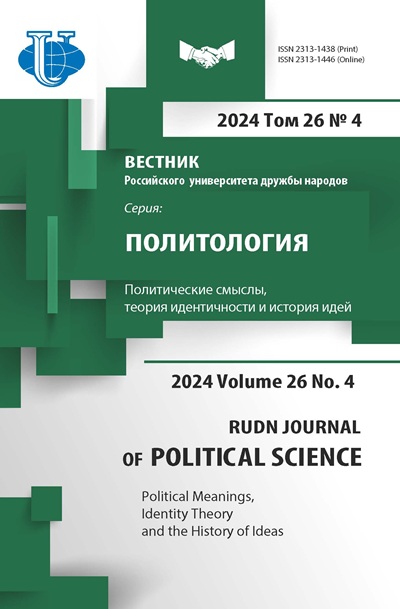Многополярный мир: современная политическая повестка
- Авторы: Денильханов А.Х.1
-
Учреждения:
- Московский государственный университет имени М.В. Ломоносова
- Выпуск: Том 26, № 4 (2024): Политические смыслы, теория идентичности и история идей
- Страницы: 605-618
- Раздел: ТЕОРИЯ И ПРАКТИКА
- URL: https://journal-vniispk.ru/2313-1438/article/view/322395
- DOI: https://doi.org/10.22363/2313-1438-2024-26-4-605-618
- EDN: https://elibrary.ru/VJDVKM
- ID: 322395
Цитировать
Полный текст
Аннотация
Либеральные ценности, выработанные западной идеологией и политической наукой на протяжении трех столетий, составляли методологическую базу в политике многих стран, ориентированных на свободу и демократию, при решении сложных социально-политических и политико-философских проблем. На их основе коллективным Западом строился однополярный мир с безусловной гегемонией определенных идеологических установок. В силу исчерпанности этих установок сегодня и отсутствия новых, которые поддерживали бы доминирующее положение западных стран на международной арене, против стран, выбравших политический вектор, основанный на иной системе ценностей, ведется информационная война. В современных условиях мирового тренда на многополярность создаются союзы государств, ориентированные на сохранение самоидентичности и конструктивный диалог со всеми, кто признает ее. Объективные причины данного тренда обусловлены прежде всего глобализационными процессами, происходящими в мировой экономике. В связи с развитием логистических технологий естественно возникла необходимость выработки новых форм сотрудничества. Одним из способов такой регламентации отношений издавна было объединение в ассоциации, альянсы, союзы и т.п. В этой связи для России - трансконтинентального государства, занимающего частично территории Европы и Азии, наиболее перспективным стратегическим направлением является парадигма евразийства, имеющая уже столетнюю историю, главной целью которой является гармонизация межрегиональных отношений. В статье проводится параллель между мыслителями евразийства - мировоззренческого движения, возникшего в среде русской эмиграции начала прошлого века, - и современностью с целью выработки наиболее приемлемых политических ориентиров в стремительно меняющемся глобализированном мире, основанных не только на экономических стратегиях государств, но и общих базовых ценностях культуры.
Ключевые слова
Об авторах
Асланбек Хаважович Денильханов
Московский государственный университет имени М.В. Ломоносова
Автор, ответственный за переписку.
Email: aslanbekk@yandex.ru
ORCID iD: 0000-0002-5593-2695
кандидат политических наук, доцент кафедры философии политики и права философского факультета
Москва, Российская ФедерацияСписок литературы
- Agursky, M. (1980). Ideology of National Bolshevism. Paris: Umsa-Press. (In Russian).
- Alimov, R.K. (2018). Shanghai Cooperation Organization and Greater Eurasia. Bulletin of International Organizations, 13(3), 19–32. https://doi.org/10.17323/1996-7845-2018-03-01. (In Russian and English).
- Danilevsky, N.Ya. (2008). Russia and Europe. A look at the cultural and political relations of the Slavic world to the Germanic-Romance. Moscow: Institute of Russian Civilization. (In Russian).
- Dugin, A.G. (2007). Postmodern geopolitics: the times of new empires, essays on geopolitics of the XX century. St. Petersburg: Amphora. (In Russian).
- Dugin, A.G. (2002). Report at the founding congress of the OPOD «Eurasia» (April 21, 2001). In Fundamentals of Eurasianism (pp. 16–26), Moscow: Arctogea Center (In Russian).
- Hara-Davan, E. (2002). Mongolian Russia: Genghis Khan and the Mongol Sphere. Moscow: Agraf. (In Russian).
- Golosenko, I.A., & Sultanov, K.V. (1998). O. Spengler’s cultural morphology on the «Faces of Russia». Journal of Sociology and Social Anthropology, 1(3), 43–54. (In Russian).
- Grishina, T.M. (2023). Evolution of Eurasian integration: features of the stages of formation and development. Human capital: Scientific and practical journal, 6, 116–124. https://doi.org/10.25629/HC.2023.06.13. (In Russian).
- Gumilev, L.N. (1993). Ethnosphere: The history of people and the history of nature. Moscow: Progres Press: Pangea Publishing house. (In Russian).
- Gutorov, V.A., & Shirinyants, A.A. (2020). Liberal tradition and modern anti-liberalism. Bulletin of the Yanka Kupala Grodno State University. Series 1. History and Archaeology. Philosophy. Political science, 12(3), 120–126. (In Russian).
- Gutorov, V.A., & Shirinyants, A.A. (2021). On a new historical interpretation of the liberal tradition. Dialogue with time, (74), 398–406. (In Russian). https://doi.org/10.21267/AQUILO.2021.74.74.028
- Katasonov, V.Yu. (2021, August 14). Oswald Spengler and Russia. Part I. Tuning fork. Online literary and historical magazine. Retrieved August 30, 2024, from https://webkamerton.ru/2021/09/osvald-shpengler-i-rossiya-chast-i (In Russian)
- Khrenov, N.A. (2019). Unfinished dialogue: Relations between Russia and the West, as they seemed to O. Spengler at the beginning of the twentieth century. Scientific Electronic Journal. Philosophical letters. Russian-European Dialogue, 2(1), 134–164. (In Russian).
- Korobeynikova, L.A., & Gil, A.Y. (2018). Globalization processes: Analysis and concepts. Tomsk State University Journal, (431), 54–61. (In Russian). https://doi.org/10.17223/15617793/431/7
- Korovnikova, N.A. (2018). Greater Eurasia: Axiological foundations. Greater Eurasia: development, security, cooperation, (1), 517–519. (In Russian).
- Kosharny, V.P. (2007). Eurasianism. In The Great Russian Encyclopedia: 2004–2017, (9). (In Russian).
- Kosharny, V.P. (2021). Pre-Eurasian motives in sociology by N.Ya. Danilevsky. University proceedings. Volga region. Social sciences, (2), 110–116. (In Russian). https://doi.org/10.21685/2072-3016-2021-2-11
- Lamansky, V.I. (1892). Three worlds of the Asian-European continent. St. Petersburg: Tipochromo-lit. A. Tranchel. (In Russian).
- Mackinder, H.J. (1995). Geographical axis of history. Polis. Political Studies, (4), 162–169. (In Russian).
- Pochta, Yu.M. (2024). The need to overcome the cultural hegemony of the Reserve in political science on the example of the problem of modern Islamist terrorism. RUDN Journal of Political Science, 26(1), 7–17. https://doi.org/10.22363/2313-1438-2024-26-1-7-17. (In Russian).
- Rachinsky, A. (2015). Russia and Europe. Notes on the history of the issue. Retrieved April, 28, 2024 from: http://pravkrug.ru/obobshchestve/tserkov-i-mir/item/346 (In Russian).
- Savitsky, P.N. (2003). Geographical and geopolitical foundations of Eurasianism. In Russkiy mir: Geopolitical notes on Russian history (pp. 799–809). Moscow: Eksmo (In Russian).
- Shirinyants, A.A. (2017). V.I. Lamansky — the Eurasian before Eurasianism. In The Eurasian idea and integration processes in the post-Soviet space (pp. 7–17). Kokshetau: Kokshetau State University named after Sh. Ualikhanov (In Russian).
- Spengler, O. (1993). The Decline of Europe. Essays on the morphology of world history. 1. Gestalt and reality. Moscow: Mysl. (In Russian).
- Trubetskoy, N.S. (1920). Europe and humanity: Library of primary sources of Eurasians: the 20–30ths. Sofia: Bulgarian-Russian publishing House. (In Russian).
- Tsaregorodtsev, S.S., & Shirinyants, A.A. (2018). In search of meaning: Ideas as a factor of politics. Bulletin of Russian Nation, 1(59), 64–78. (In Russian).
- Tsymbursky, V. (2024). Return to the «Island of Russia». Moscow: Rodina. (In Russian). Tsymbursky, V. (1998). Two Eurasias: Homonymy as the key to the ideology of early Eurasianism. Bulletin of Eurasia, 1–2 (4–5), 6–31. (In Russian).
- Wimmer, V., & Sosnovsky, A. (2024). Versailles: A desired world or a plan for a future war? St. Petersburg. (In Russian).
Дополнительные файлы








